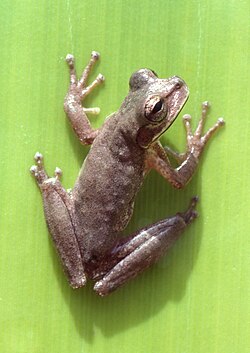| Tepuihyla rodriguezi | |
|---|---|
 | |
| Scientific classification | |
| Kingdom: | Animalia |
| Phylum: | Chordata |
| Class: | Amphibia |
| Order: | Anura |
| Family: | Hylidae |
| Genus: | Tepuihyla |
| Species: | T. rodriguezi |
| Binomial name | |
| Tepuihyla rodriguezi (Rivero, 1968) | |
| Synonyms [2] | |
| |
Tepuihyla rodriguezi, also known as the Rodriguez's Amazon treefrog is a species of frog in the family Hylidae found in southeastern Venezuela and Guyana. [2]
Tepuihyla galani, assessed as "near threatened" by the International Union for Conservation of Nature. [1] is now considered a junior synonym of Tepuihyla rodriguezi. [2]
